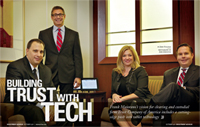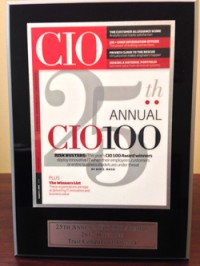This week, I sat down for Q&A with GetSwift’s marketing team and I thought I’d share the whole interview below. The article was originally posted on GetSwift’s Blog, which publishes stories and tips on how companies are making their delivery management smarter. Give it a read and please feel free to comment to continue the conversation. Here it is…
Q&A With GetSwift CTO Dennis Noto
GetSwift’s head of tech answers why he got into logistics, the future of the industry, and how to build a game-changing company culture.
Before joining GetSwift, Dennis Noto’s career had spanned nearly every facet of the technology industry. Most recently, as the Executive Architect/CTO of IBM’s Watson for Business, he advised Fortune 500 companies on how to harness AI for their business. Before that, Noto spent much of his career as a financial services CIO helping financial institutions accomplish big tasks such as clearing billions of Wall Street trades instantly. And, in 2012, he won the CTO 100 Award for his work as CIO of Trust Company of America, where he developed a trading application that financial advisors could use across any browser or device.
Last year, he became the CTO of GetSwift, with the task to improve, evolve and build the most advanced logistics technology platform in the industry. We asked him about his vision to improve logistics and delivery management, how to spark innovation, and what it takes to build a strong company culture.
Why did you want to get into delivery management?
I’ve spent most of my career in fintech and was looking to apply everything I’ve learned—high-transaction volumes, real-time systems, innovative product, great UX, solving problems with simplicity, and more—to a brand new industry. I looked at delivery management and did my research. Everything today is delivery, competition in the field was open, and the technology in logistics was, frankly, old. It begged for software as a service. I saw a green field, so I said to myself, “It’s time to take a proven methodology from fintech to build game-changing logistics industry technology.”
What is the big opportunity to make a difference in delivery management?
The big opportunity is that logistics is so much more than dispatch, routing, and tracking your deliveries, and we’re building a holistic platform that not only helps you deliver efficiently but fuels your whole business. We offer business intelligence that you can feed back into your delivery system and overall business, seamless cash management, scheduling your drivers, an online customer marketplace to sell your products, and beyond. We are already offering more of these pie slices—thanks to our acquisition Delivery Biz Pro and Scheduling+—but many more features are coming down the pike.
You’ve written before about your goal of wowing customers. What do you mean by this?
When you’re bringing a product to market, it’s so important that it helps your customer increase revenue, cut expenses, automate, upsell or cross-sell. What is also really critical is that it wows a customer with UX and UI Experience that knocks them off their seat.
How do you wow customers in delivery management?
You wow the dispatcher on how easy it is to automate tens of thousands of deliveries at once to your fleet of drivers; you wow your drivers with the seamless mobile app experience to accept and manage orders; you wow the CEO because they’re optimizing time-to-deliver and meeting the revenue metrics to run their business; and you’re wowing the end customer because they’re getting a better product, sooner, and they’re well-informed before, during, and after the delivery.
When I asked you about wowing I thought maybe you’d talk about product, and it’s interesting that most of your answer was about user experience.
Product and UX go together. As a user, you need both. Let me tell a story. At Trust Company of America (where Noto was CIO for four years) our customers were large financial advisory firms, and we decided to do something new: allow CPAs to run their trading applications right form their tablets. At first there was pushback, with our client wondering how they’d train CPAs. So I put the iPad app in the hands of the COO and told him, “Give it to all your people. If they can’t run this app without a user’s manual, I failed at my job.” They all loved it. The point was: we combined complicated features with awesome customer experience. If you can’t be intuitive about what you do, you shouldn’t be bringing it to your customers.
Let’s talk about innovation and company culture. You’ve said that technology innovation is not strictly about technology anymore. Can you explain that?
We all can be on a level playing field with technology. The question is not about technology—it’s about the people that make the decisions that use the technology, who build the product to solve a problem and give the experience. You can have the best technology in the world, but if you are not solving the right problem and don’t have people to create that awesome experience, you won’t succeed. If the culture and objective isn’t right, you’re done. How much of your time do you spend thinking about culture?
A group teach-back with the Denver and New York teams
How much of your time do you spend thinking about culture?
A lot. It’s not that it chews up my time. But it’s a matter of how engaged you are with your people. Here’s another story. When we opened the Denver office (GetSwift’s global tech team HQ), we set up mobile sit-and-stand desks for the team. But here’s the key: I told everybody, “Let me know what you think.” Some people actually didn’t like it and wanted to be back in cubicles, so we built out that option for them. It’s about listening to people, engaging with them, and empowering them to be their best.
By the way, most of the time our team does the setting-up and building as a team because we’ve fostered that collaborative culture. When new bar stools arrive in the kitchen, our team is already setting them up. Everybody pitches in and grabs a screwdriver.
People also need to know what their purpose is in the greater good of the organization, because people are motivated by a sense of belonging—it’s actually one of Maslow’s hierarchy of needs, which I’m a strong believer in. That’s why we hold monthly town halls, where our leaders talk about what we’re working on and where the organization is headed. It doesn’t stop there: We also hold department “campfires” so we can discuss what’s going well and what isn’t, and group teach-backs so we can learn from each other. And then sometimes we’ll have some drinks together or, recently, we actually went out to play old arcade games. I had no idea the team wanted to do that, but it was fun!
Business Analyst Eiden Hughes presents a heat map to help the team understand GetSwift’s trajectory this year.
So, how’s it going at GetSwift? Are you proud of what you’re accomplishing?
We’re releasing code to production every three weeks. We probably did 1,000 stories in the first quarter. We’re producing functionality that causes our business team in New York to say “Wow! We’ve been waiting for this!”
With our customers, they are seeing a recurring steady stream of new product features, sub-system improvements, and most importantly service availability enhancements. Every three weeks, we deliver for our customers new enhancements based on unique business intelligence, and then we do it again. That kind of productive environment fuels a great culture, and then we have a virtuous cycle: people engaged in a great culture leads to even more productivity.



